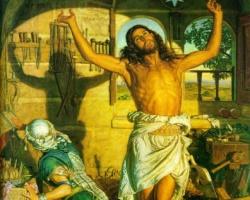In Holman Hunt’s classic painting, Jesus comes to the end of what appears to be another long workday at His father’s carpentry shop. He is stripped to the waist and stretching, and the light of dusk seeps through the room at such an angle that a shadow appears in the form of a cross on the wall behind Jesus. Even the most unaware observer can’t miss the artist’s point: In His youth, Jesus could never escape the cross—it hovered over Him daily.1
No other symbol in the history of humanity has become as iconic as the cross. Instantly recognized by millions of people, the cross has inspired hope and courage, and brought new life to untold numbers of people since the scandalous, but necessary, death of Jesus Christ. To Holman Hunt, the cross, “the emblem of suffering and shame,”2 was not just a historical event, or even symbolic of a future hope, but a living reality.
When Jesus instructed His followers to take up their cross and follow Him (
The gospel and the cross are intertwined, so closely related that you cannot see one without the other. The gospel is the cross. In fact, we need not look far to get a very clear picture of the gospel; just look at its shape. The two beams of the cross—one vertical, the other horizontal—tell us all we need to know about the gospel. The cross-shaped gospel has to do with man being reconciled to God (the vertical beam) and to one another (the horizontal beam) through the sacrifice of Jesus Christ, the Messiah who died in our place and for our sins. Sadly, many times we disconnect the two beams, undermining the power of the gospel. When we disconnect the vertical and horizontal beams, the Christ-follower and the church limp along, not functioning at full capacity.
Oh, but the beauty of the cross-shaped gospel is when both dimensions are lived out through a life that has been justified and growing in Christ-exalting holiness, along with loving and engaging our neighbors and society for the glory of God. Church and life just doesn’t get any better than when we are living the cross-shaped gospel.
Life is at its richest when we are living in close communion with God and loving our neighbors at the same time. When life becomes solely about quiet times and Bible studies, there’s this innate feeling that something is missing, because something is! On the other hand, when life is just about serving and loving others, and it doesn’t flow from deep affections for God, a sense of disequilibrium creeps in as well.
The cross-shaped gospel isn’t ultimately about our enjoyment or living my life to the fullest. These are but by-products of two greater realities—the glory of God and the betterment of our world. My prayer for you, as you begin this book, is that God will be even more glorified in your life, and that your spheres of influence are bettered because you’re living this cross-shaped gospel.
Notes
1. John Stott, The Cross of Christ (Downers Grove, Ill.: InterVarsity, 1986), 17. Hunt painted “The Shadow of Death” while in the Holy Land from 1870-73.
2. So described by George Bennard in verse 1 of his classic hymn, “The Old Rugged Cross.”




